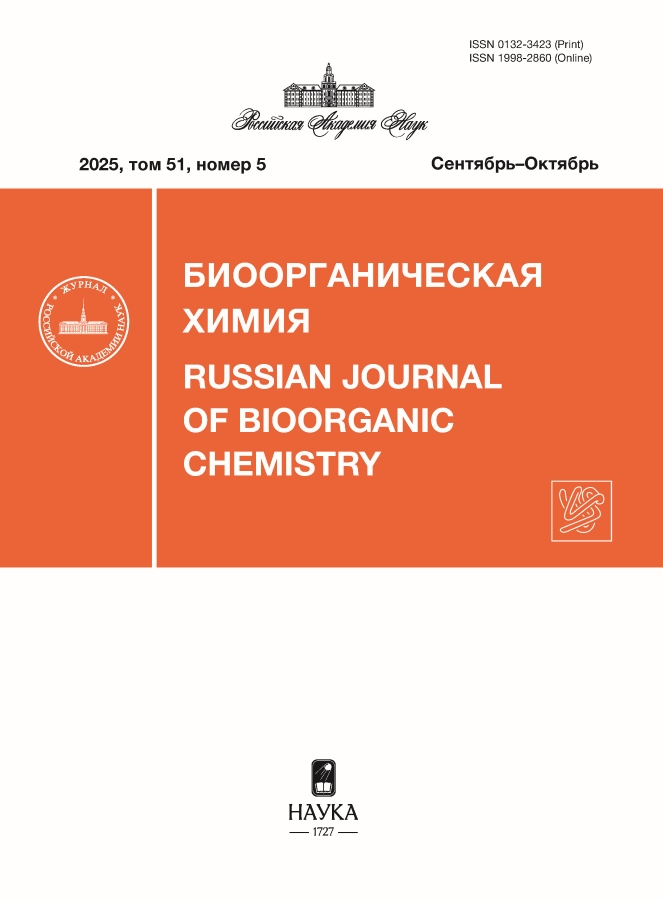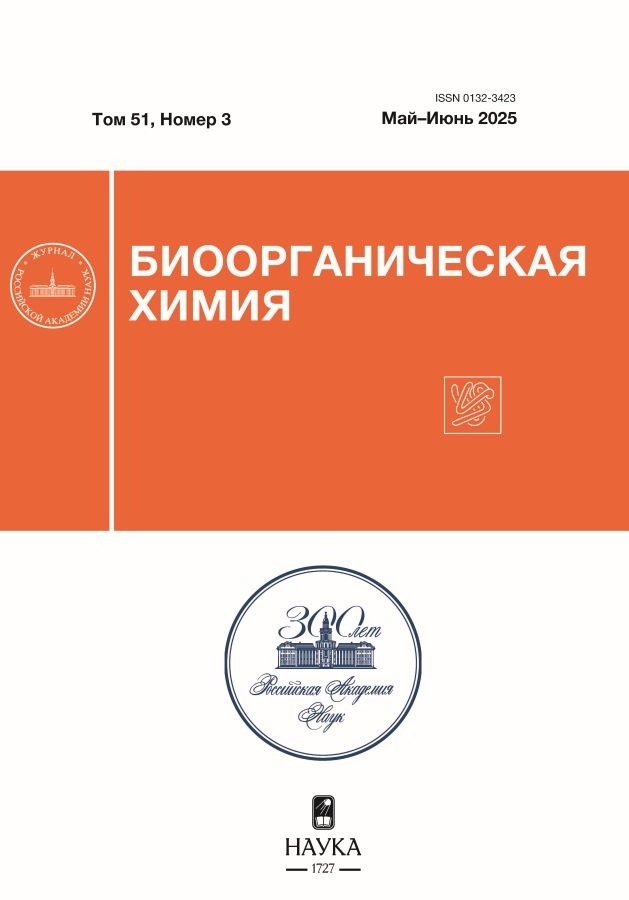Синтез и изучение цитотоксичности производных 3β-ацетоксиурс-12-ен-28-оил-тиомочевины
- Авторы: Попов С.А.1, Борисова Т.Д.1,2, Шульц Э.Э.1, Маренина М.К.1, Мешкова Ю.В.1, Толстикова T.Г.1
-
Учреждения:
- Новосибирский институт органической химии им. Н.Н. Ворожцова СО РАН
- Новосибирский государственный технический университет
- Выпуск: Том 51, № 3 (2025)
- Страницы: 418-431
- Раздел: ОБЗОРНАЯ СТАТЬЯ
- URL: https://rjonco.com/0132-3423/article/view/686914
- DOI: https://doi.org/10.31857/S0132342325030053
- EDN: https://elibrary.ru/KQDCCS
- ID: 686914
Цитировать
Полный текст
Аннотация
Взаимодействием 3β-ацетокси-урс-12-ен-28-оил-хлорида с роданидом калия был получен 3β-ацетоксиурс-12-ен-28-оил-изотиоцианат. В результате конденсации тритерпенового ацилизоцианата с рядом аминопроизводных синтезирован набор замещенных 3β-ацетоксиурс-12-ен-28-оил-тиомочевин с выходами 69–88%. CuAAC-реакция циклоприсоединения N-(2-азидоэтилкарбамотиоил)-3-ацетоксиурс-12-ен-28-оил-амида с пропаргиловым спиртом и 3-(проп-2-инилокси)-4,5-((R,S)-метоксиметилендиокси)-бензоатом приводила к образованию гибридных ацилтиомочевин, содержащих 1,2,3-триазольный линкер с выходами 72 и 75%. В CuAAC-реакции N-(проп-2-инилкарбамотиоил)-3β-ацетоксиурс-12-ен-28-оил-амида с замещенными азидами ацилтиомочевины, содержащие 1,2,3-триазол, выделены только с умеренными выходами 48–62%. Использование однореакторного варианта синтеза с получением замещенных (1H-1,2,3-триазол-4-ил)метанаминов в реакции пропаргиламина с замещенными азидами с последующей конденсацией с 3β-ацетоксиурс-12-ен-28-оил-изотиоцианатом позволило повысить выход 1,2,3-триазолсодержащих ацилтиомочевин до 65–85%. Полярные тритерпеновые ацилтиомочевины, содержащие карбоксильную или спиртовые группы, проявляли высокую ингибирующую активность в отношении клеток HepG2, существенно превосходившую стартовое соединение – урсоловую кислоту, а также были более селективными по сравнению с доксорубицином. Среди ацилтиомочевин, продуктов CuAAC-циклоприсоединения, наиболее активным было полярное производное с (1H-1,2,3-триазол-4-ил)метанольным заместителем, цитотоксичное для всех изученных клеток, включая неопухолевый контроль, но превосходящее по селективности доксорубицин. Гибриды урсанового ряда с производными ацилтиомочевин представляют интерес для дальнейшего изучения в качестве перспективных противоопухолевых агентов.
Ключевые слова
Полный текст
Об авторах
С. А. Попов
Новосибирский институт органической химии им. Н.Н. Ворожцова СО РАН
Автор, ответственный за переписку.
Email: spopov@nioch.nsc.ru
Россия, 630090 Новосибирск, просп. Акад. Лаврентьева, 9
Т. Д. Борисова
Новосибирский институт органической химии им. Н.Н. Ворожцова СО РАН; Новосибирский государственный технический университет
Email: spopov@nioch.nsc.ru
Россия, 630090 Новосибирск, просп. Акад. Лаврентьева, 9; 630073 Новосибирск, просп. К. Маркса, 20
Э. Э. Шульц
Новосибирский институт органической химии им. Н.Н. Ворожцова СО РАН
Email: spopov@nioch.nsc.ru
Россия, 630090 Новосибирск, просп. Акад. Лаврентьева, 9
М. К. Маренина
Новосибирский институт органической химии им. Н.Н. Ворожцова СО РАН
Email: spopov@nioch.nsc.ru
Россия, 630090 Новосибирск, просп. Акад. Лаврентьева, 9
Ю. В. Мешкова
Новосибирский институт органической химии им. Н.Н. Ворожцова СО РАН
Email: spopov@nioch.nsc.ru
Россия, 630090 Новосибирск, просп. Акад. Лаврентьева, 9
T. Г. Толстикова
Новосибирский институт органической химии им. Н.Н. Ворожцова СО РАН
Email: spopov@nioch.nsc.ru
Россия, 630090 Новосибирск, просп. Акад. Лаврентьева, 9
Список литературы
- Xing Y.L., Bi L.W., Zhao Z.D., Xia T.J. // Adv. Mater. Res. 2013. V. 781. P. 787–791. https://doi.org/10.4028/www.scientific.net/AMR.781-784.787
- Jäger S., Trojan H., Kopp T., Laszczyk M.N., Scheffler A. // Molecules. 2009. V. 14. P. 2016–2031. https://doi.org/10.3390/molecules14062016
- López-Hortas L., Pérez-Larrán P., González-Muñoz M.J., Falqué E., Domínguez H. // Food Res. Int. 2018. V. 103. P. 130–149. https://doi.org/10.1016/j.foodres.2017.10.028
- Pironi A.M., de Araújo P.R., Fernandes M.A., Salgado H.R.N., Chorilli M. // Crit. Rev. Anal. Chem. 2018. V. 48. P. 86–93. https://doi.org/10.1080/10408347.2017.1390425
- Nistor G., Trandafirescu C., Prodea A., Milan A., Cristea A., Ghiulai R., Racoviceanu R., Mioc A., Mioc M., Ivan V. // Molecules. 2022. V. 27. P. 6552. https://doi.org/10.3390/molecules27196552
- Wei Z.-Y., Chi K.-Q., Wang K.-S., Wu J., Liu L.-P., Piao H.-R. // Bioorg. Med. Chem. Lett. 2018. V. 28. P. 1797–1803. https://doi.org/10.1016/j.bmcl.2018.04.021
- Wang W., Lei L., Liu Z., Wang H., Meng Q. // Molecules. 2019. V. 24. P. 877. https://doi.org/10.3390/molecules24050877
- Viji V., Helen A., Luxmi V.R. // Br. J. Pharmacol. 2011. V. 162. P. 1291–1303. https://doi.org/10.1111/j.1476-5381.2010.01112.x
- Luan T., Jin C., Jin C.-M., Gong G.-H., Quan Z.-S. // J. Enzyme Inhib. Med. Chem. 2019. V. 34. P. 761–772. https://doi.org/10.1080/14756366.2019.1584622
- Larik F.A., Shah M.S., Saeed A., Shah H.S., Channar P.A., Bolte M., Iqbal J. // Int. J. Biol. Macromol. 2018. V. 116. P. 144–150. https://doi.org/10.1016/j.ijbiomac.2018.05.001
- Aly A.A., Ahmed E.K., El-Mokadem K.M., Hegazy M.E.A.F. // J. Sulfur Chem. 2007. V. 28. P. 73–93. https://doi.org/10.1080/17415990601124691
- Saeed A., Flörke U., Erben M.F. // J. Sulfur Chem. 2014. V. 35. P. 318–355. https://doi.org/10.1080/17415993.2013.834904
- Saeed A., Erben M.F., Bolte M. // Spectrochim. Acta Part A Mol. Biomol. Spectrosc. 2013. V. 102. P. 408– 413. https://doi.org/10.1016/j.saa.2012.10.043
- Mahmood A., Shah S.J.A., Iqbal J. // Eur. J. Med. Chem. 2022. V. 231. P. 114162. https://doi.org/10.1016/j.ejmech.2022.114162
- Asegbeloyin J.N., Oyeka E.E., Okpareke O., Ibezim A. // J. Mol. Struct. 2018. V. 1153. P. 69–77. https://doi.org/10.1016/j.molstruc.2017.09.093
- Li Z., Zhang Y., Wang Y. // Phosphorus, Sulfur Silicon Relat. Elem. 2003. V. 178. P. 293–297. https://doi.org/10.1080/10426500307952
- del Campo R., Criado J.J., Gheorghe R., González F.J., Hermosa M.R., Sanz F., Manzano J.L., Monte E., Rodrı́guez-Fernández E. // J. Inorg. Biochem. 2004. V. 98. P. 1307–1314. https://doi.org/10.1016/j.jinorgbio.2004.03.019
- Huang X., Huang R., Liao Z., Pan Y., Gou S., Wang H. // Eur. J. Med. Chem. 2016. V. 108. P. 381– 391. https://doi.org/10.1016/j.ejmech.2015.12.008
- Huang X.-C., Wang M., Pan Y.-M., Yao G.-Y., Wang H.-S., Tian X.-Y., Qin J.-K., Zhang Y. // Eur. J. Med. Chem. 2013. V. 69. P. 508–520. https://doi.org/10.1016/j.ejmech.2013.08.055
- Liu J., Lu Y., Wang J., Bi L., Zhao Z. // Chinese J. Org. Chem. 2017. V. 37. P. 731–738. https://doi.org/10.6023/cjoc201610017
- Baltina L.A., Davydova V.A., Tolstikova T.G., Zarudii F.A., Kondratenko R.M., Tolstikov G.A. // Pharm. Chem. J. 1991. V. 25. P. 705–710.
- Popov S., Qi Z., Wang C., Shults E. // J. Sulfur Chem. 2023. P. 523–541. https://doi.org/10.1080/17415993.2023.2193669
- Popov S.A., Semenova M.D., Baev D.S., Frolova T.S., Shestopalov M.A., Wang C., Qi Z., Shults E.E., Turks M. // Steroids. 2020. V. 162. P. 108698. https://doi.org/10.1016/j.steroids.2020.108698
- Sang S., Lapsley K., Rosen R.T., Ho C.-T. // J. Agric. Food Chem. 2002. V. 50. P. 607–609. https://doi.org/10.1021/jf0110194
- Tkachev A.V., Denisov A.Y. // Tetrahedron. 1994. V. 50. P. 2591–2598. https://doi.org/10.1016/S0040-4020(01)86975-1
- Qi Z., Xie P., Wang Z., Zhou H., Tao R., Popov S.A., Yang G., Shults E.E., Wang C. // Arab. J. Chem. 2024. V. 17. P. 105762. https://doi.org/10.1016/j.arabjc.2024.105762
Дополнительные файлы















